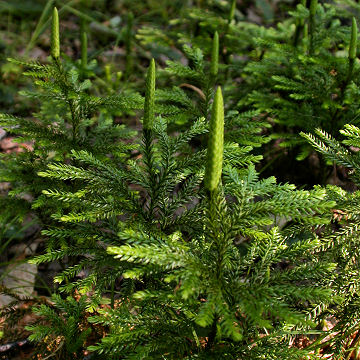

Dendrolycopodium obscurum - (image 1 of 3)
Taxonomy
Family: Lycopodiaceae
Habitat
Moist to dry woods, mossy barrens, rocky or sandy areas, and bogs.
Associates
In young woods of Acer rubrum and Sassafras albidum it grows with Lycopodium clavatum and Diphasiastrum digitatum.
Distribution
Morphology
Low evergreen from deeply buried, horizontal stems, erect stems to 30cm high, tree-like with many forked, subterete branches. Leaves linear, acute, 3-5mm long, in 6-8 ranks evenly spaced around the stem. Cones (strobiles) to 6 cm long, terminal, sessile, solitary or in groups of 2-3.
Notes
Produces spores from late August to mid November.
Wetland indicator: FAC
The branchlets of this species are noticeably flattened. In the past D. dendroideum and D. hickeyi, which have more rounded branches, have been treated as varieties of D. obscurum.
References
Haines, A. 2011. Flora Novae Angliae: a manual for the identification of native and naturalized higher vascular plants of New England. Yale University Press, New Haven, CT.
Lellinger, D. B. and M. Evans. 1985. A Field Manual of the Ferns & Fern Allies
of the United States and Canada.
Smithsonian Institution Press. Washington, D.C.
Swink, F. and G. Wilhelm. 1994. Plants of the Chicago Region.
Indiana Academy of Science. The Morton Arboretum. Lisle, Illinois.
|
Michael Hough © 2005, 2018 |